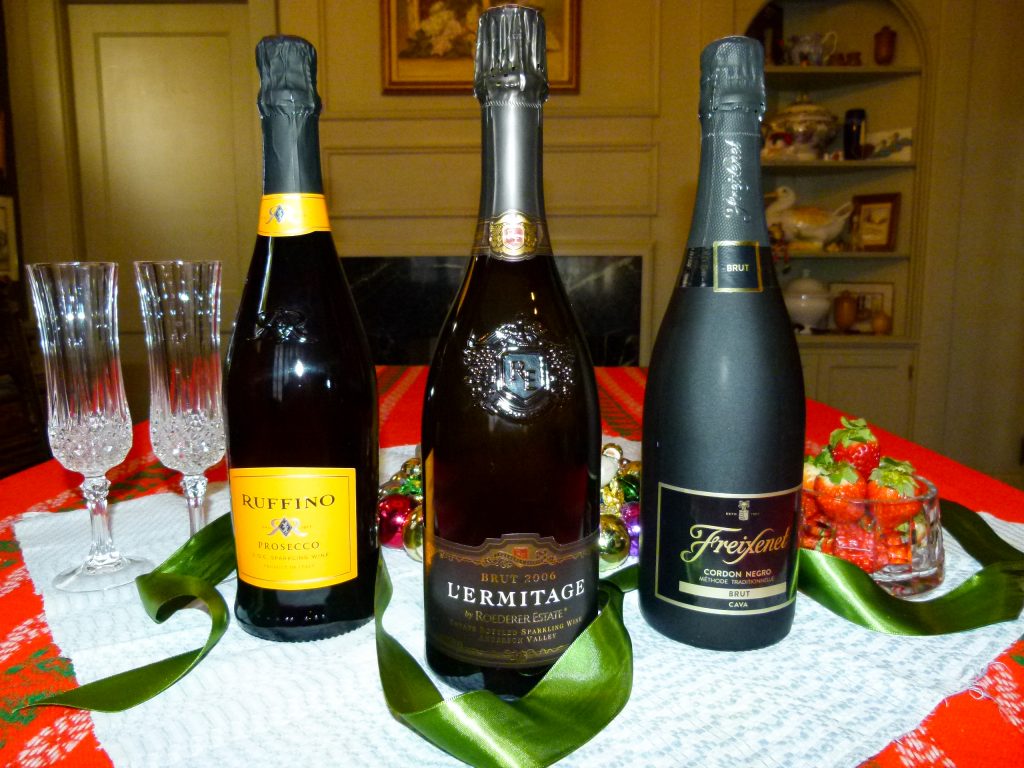The Chilling Task of Buying Champagne
- Like
- Digg
- Del
- Tumblr
- VKontakte
- Buffer
- Love This
- Odnoklassniki
- Meneame
- Blogger
- Amazon
- Yahoo Mail
- Gmail
- AOL
- Newsvine
- HackerNews
- Evernote
- MySpace
- Mail.ru
- Viadeo
- Line
- Comments
- Yummly
- SMS
- Viber
- Telegram
- Subscribe
- Skype
- Facebook Messenger
- Kakao
- LiveJournal
- Yammer
- Edgar
- Fintel
- Mix
- Instapaper
- Copy Link

Several possible champagne choices for New Year’s Eve. (photo: Rick Handler)
It’s often said that the Inuit, who represent just one culture of the Eskimo-Aleut diaspora, have more than fifty words to describe snow. Turns out, that’s true. Soft snow, small snowflakes, and biting blizzard-blown ice crystals all have different lexemes. So, at this time of year, when we prepare to celebrate the traditions of another cold New Year’s Eve, it’s not surprising to learn that we—we whose lives are mostly spent indoors scavenging for leftovers in the fridge—have the hardest challenge of the year: getting to the liquor store to buy champagne. Because, well, there are more than fifty words to describe it. And champagne is really just one appellation of a larger diaspora of sparkling wines. Like cava. Or Prosecco. Asti spumante. And whatever Cold Duck might be.
So, here is a brief buyer’s guide to bubbly. Best read now, so you can breeze through the PLCB’s bounty of bottles and get back home—hey, it’s nippy and slushy out there—quickly.
True Champagnes
First, champagne to be labeled Champagne (with a capital C) must be bottled in a certain region of France. It’s an appellation tied to a region east of Paris, and the wine must be fermented in a traditionally standardized way from grapes that must be picked by hand. There are many words on a bottle of Champagne. And while you don’t need to speak French to understand them, they do relate to very specific characteristics.
Of relative importance are the flavor designations and the compositions. Champagne’s flavor has as much to do with the variety of grapes employed as the sweetness that each harvest of that variety imparts. Champagnes labeled brut are “dry,” which means they have something less than 12 grams per liter (g/l) of sugar. If the label says extra dry, that usually means it’s a bit sweeter than brut (but not always), and if the word sec is used, it means sweet, or somewhere between 17 and 32 g/l of sugar. Those are the basics, but leave it to centuries of Champagne making for vintners to add descriptions like extra sec (drier than sec,) demi sec (sweeter than sec) or doux (really sweet and more than 50 g/l of sugar) to make you scratch your head. And speaking of head scratching, these levels of sweetness may affect your “morning after.” The more sugar you drink in your alcohol, the more likely you’ll feel hung over. Which is one reason you might pay more for the brut than the sec. Another reason brut is more expensive is that it’s universally more popular.
Also on the label you’ll read words like non vintage or cuvée or blanc de blancs. No less confusing than why a French pencil (le crayon) is masculine and a pen (la plume) feminine, these words describe the composition of the Champagne. There’s vintage which will specify a certain year (or harvest) from which the Champagne was fermented, or there is non vintage (sometimes just NV) which means the Champagne was blended from different harvests of different years. Better Champagnes ferment in the bottle for no less than three years.
Cuvée is the most curious of descriptions. Cuvée means that a wine (not just Champagne) is a blend of different grapes and cuvee speciale suggests that the vintner has some proprietary blend of grapes (but then, not always unique, and sometimes the usage is more boastful than true). But, when cuvèe is used in the context of Champagne making, it’s supposed to mean something more: that the vintner began the process by using only the first flow of juice from the grape press and not all of the juice that was pressed. Know, too, that Champagne is usually a blend of different grapes, of which each variety may have been pressed to produce different volumes of first flowing juices, and it all becomes crystal clear. Cuvèe really just means “what’s in the tank.” Got that? Good, because even if you lived your last thirty years on a vineyard in Éparnay, you would have a much harder time explaining cuvée than why the French word for grapefruit is pamplemousse, or, indeed, why the English word likens a very large, sour citrus to a grape.
Descriptions of blanc de blancs, blanc de noir and rosé are much easier to understand. Blanc de blancs is made only from white grapes, blanc de noir from red grapes (which, when the juice is gently pressed, is white), and rosé is white juice fermented with just a soupçon (French for dollop) of red wine.
As to the pricing of champagnes, well, New Year’s Eve 2023 will have passed by the time any oenophile could ever explain how wines are priced. But you can certainly hope that the higher priced champagne is better than the lower priced one. So, the bottom line is this: Go cheap if you’re planning to have mimosas (mixed with orange juice), moderate if making a champagne cocktail (with a cube of sugar, a dash of bitters, and/or a twist of orange peel), and stretch your comfort level for more expensive Champagne (that’s brut) if that’s all you’re drinking.
Spanish, Italian, and California Bubbly
Yet, hold on. Champagne—again, an appellation of a specific region—is just a small subset of sparkling wines. Spain famously makes cava, Italy Prosecco and Asti, and Germany sekt, not to mention that California offers all of these in varying tastes, blends, and prices. Here’s what you might want to know when you’re dashing down the sparkling wine aisle at your local Fine Wine & Good Spirits store.
Cava, derived from a Spanish word for caves or cellars, is produced mostly in Catalonia from specifically local grape varieties. Freixenet is the most popular brand in Pennsylvania, and there are several compositional varieties to choose from. But many other labels are available, too. Cava is a particularly attractive bubbly because some of the best cost just $18 per 750 ml bottle.
Prosecco and Asti spumante (now just called Asti) are sparkling wines from specific areas of Italy. Prosecco originated in the town of Prosecco, from the Prosecco variety of grape, but is now made in many areas of Italy. Asti, likewise, comes from Asti. The word spumante means sparkling, but there is also Asti frizzante, which is less sparkling. And it’s also known as moscato d’Asti, because it’s made from the moscato grape which is sweeter than Prosecco.
The PLCB offers an even wider selection of Proseccos than cavas, the best labels costing no more than $20. The better Astis are just $19
Cold Duck is based on an ancient recipe intended not to waste older red wine (like a burgundy) by adding champagne. It’s not made that way these days, of course, but the recipe speaks for itself. Andre is the single provider to the PLCB. At just $6.39 that, too, should tell you a lot.
So, enjoy your New Year’s knowing you might now understand a few more words with which to make a sparkling wine selection. If you wish to more accurately describe the snow falling outside your window, good luck.
Recommendations to consider:
Inexpensive to Moderate
For the mimosa lover, use a dry cava and freshly squeezed orange juice. If you are using store-bought or frozen orange juice, a sweeter cava may offer more balance. Try Freixenet Cordon Negro Brut, on sale now, at $12.99 for 750 ml. (PLCB # 8422)
For a champagne cocktail, traditional or otherwise, where the bubbly is by far the main ingredient, a good Prosecco will do just fine. Check out Ruffino Prosecco, also on sale now, at $12.99 for 750 ml. (PLCB # 3810)
Or, for something slightly more upscale, try Santa Margherita Prosecco Superiore Valdobbiadene, also on sale now, at $19.99 for 750 ml. (PLCB # 5268)
More Expensive
And for the stalwart purist—one who is just going with Champagne and nothing else—try one of these selections:
At $49.99 for 750 ml, look for Roederer Estate L’Ermitage 2011 Brut (PLCB # 76754).
At $159.99, try Krug Grand Cuvee Non Vintage (PLCB # 12267).
Or, if you want to shoot the moon, pay $249.99 for Krug Vintage 2004 (PLCB # 73782).
Our recommendations are all sold through your larger PLCB Fine Wine & Good Spirits shops. Although not all stores may carry the same inventory or quantities, you can go online and check availability.
Happy New Year!
Prentiss Orr is a founder of Pennsylvania’s first craft vodka distillery. He often consults for other craft distillers, too.
Share on Social Media
- Like
- Digg
- Del
- Tumblr
- VKontakte
- Buffer
- Love This
- Odnoklassniki
- Meneame
- Blogger
- Amazon
- Yahoo Mail
- Gmail
- AOL
- Newsvine
- HackerNews
- Evernote
- MySpace
- Mail.ru
- Viadeo
- Line
- Comments
- Yummly
- SMS
- Viber
- Telegram
- Subscribe
- Skype
- Facebook Messenger
- Kakao
- LiveJournal
- Yammer
- Edgar
- Fintel
- Mix
- Instapaper
- Copy Link
Follow Entertainment Central
Sign up for the EC Newsletter
Latest Stories







